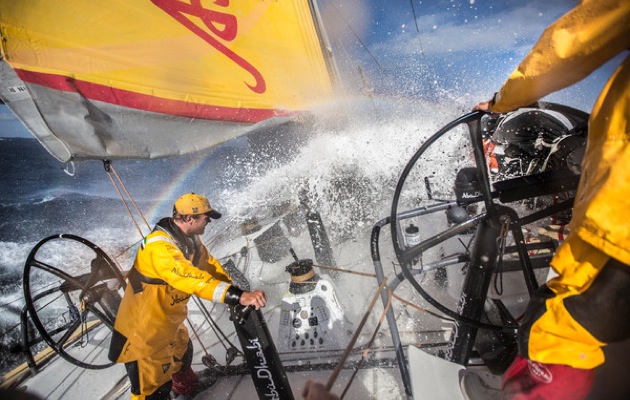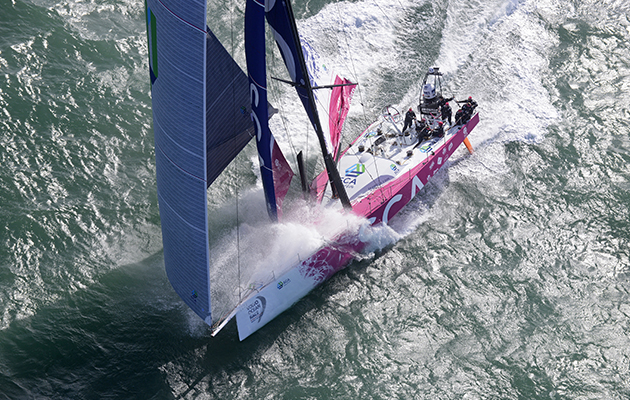Crew numbers restricted to just seven for all-male entries in next year's Volvo Ocean Race, with additional crew allowed for mixed teams
Among the raft of changes for the 2017-2018 Volvo Ocean Race currently being announced, one of the most controversial has been the change to the maximum crew numbers dependent on the number of men – or women – taking part.
For the 2017 race, which begins in one year’s time, all-male teams will be able to race with just seven crew members, one fewer than the last race. That maximum crew limit goes up to eight or nine for teams taking seven men and one or two women, while an evenly mixed team is granted five men, five women. All-female teams can race with 11 sailors.
Teams will be able to change their crew combinations from leg to leg, but must have a consistent team for the in-port race and either the previous or subsequent offshore leg. There is one exception – a team that opts to race offshore with seven male crew can take an additional female sailor for in-port racing, something of a compromise in what is otherwise a fairly revolutionary rule change.

Crew combinations for the 2016-2017 Volvo Ocean Race ©Volvo Ocean Race
There have been mixed crew ‘incentives’ in previous editions of the race – in the last race the crew size was eight (plus one non-sailing onboard reporter, known as the OBR), or nine sailors in a mixed team of no more than five men – an option no team took up. The race did see the first all-female crew since 2001’s Amer Sports Two with Sam Davies and Team SCA, but when SCA announced they weren’t renewing their campaign, it looked as if the Volvo Ocean Race would once again return to being an all-male competition.
In the announcement, Mark Turner commented: “We’re using the crew rules to incentivise skippers to bring one or more female sailors onboard. I really hope that it’s not necessary to have any rule at all in the future – but it seems it’s the only way today to ensure we can maintain progress.”
Winning skipper Ian Walker says this rule is likely to drive change because of the very limited all-male crew numbers. “The key thing is forcing you to go with just seven if you sail with all guys. If they allowed eight, I don’t think many people would change but you’d have to be pretty narrow-minded I think to sail with seven and not take any girls.
“Personally I like the idea of taking nine, because it means you can have your navigator out of your watch system. Eight felt like it was always difficult to have the navigator and skipper spend enough time together.” However, he feels the mixed ten-person crew is probably too many for the longer legs, especially given the additional food weight. “I do think that offshore you can have too many people. The boats are just not very big.”

2015 Volvo Ocean Race; Leg 5 to Itajai, Abby Ehler onboard Team SCA.
Reactions have been mixed. The announcement was welcomed by sailors such as Tracy Edwards, who skippered Maiden to second in class in 1990, the best ever result for an all female team, and Dee Caffari, who was part of Team SCA. However, others have raised concerns that it might be considered tokenism.
Abby Ehler, who was part of Team SCA as well as boat captain and bowman on Amer Sports Too in 2001-02, admits that initially she had reservations. After she spoke to current Volvo sailors Ehler was concerned that female sailors would be brought on in assistant or boat captain roles, rather than integral members of the sailing team.
“I saw the potential for female crews to be pigeon-holed into certain roles. When you look back to the SCA campaign, the girls were like sponges wanting to soak up the information and desperately trying to make the boat go faster, and that’s what they’d want to be doing alongside the guys, being involved.
“But the more I’ve talked about stuff with colleagues or peers, I think the reality is it had to happen to ensure women are still in the race. What would happen if there hadn’t been another all-female team in this race is we could have been looking at another 10-12 years until a sponsor came along.
“This is a real cultural change. It’s a bold move – it’s a little like the Nacra class, it’s going to take a little while for people to adjust to the change, but like everything change equals progress.”
Ehler compares the initiative to the under-30 rule, which requires every Volvo Ocean Race team to include two young crew. “Many of them had never had a race under their belts before, whereas now you’re effectively looking at 14 women who have just done a Volvo Ocean Race so are one step ahead of the under-30s. The guys would look for high performance young sailors, and then it would be a character decision – can they do this race?”

Volvo Ocean Race, 2015, onboard Abu Dhabi Ocean Racing, under-30 crew member Luke “Parko” Parkinson grinding.
Walker points out that his team Abu Dhabi Ocean Racing and third placed Dongfeng also successfully sailed with crew recruited from non-traditional offshore racing backgrounds. “If we put the male-female aspect aside, for any group to work well everybody needs to bring something to the team. If you think in previous races we had Adil Khalid [an Abu Dhabi national] sailing with us, and Dongfeng had two Chinese crew members. And in order for them to fit in, they have to bring something to the team. If they come along and are a bit rubbish, it’s only a matter of time before people fall out with them, or they hate it.
“Even if it’s not who you would have chosen if you were starting with a blank sheet of paper, they have to bring something. Some people are incredibly smart, some people are incredibly strong, some are great sailors, some bring the money to the programme, some bring humour. And I’m sure there wouldn’t be a problem finding good girls who will add value.
“There are people from the Olympic programme who are strong and smart and have a good attitude. But if you are looking for 6’2” girls who are strong and know how to sail a Volvo 65 offshore, the list is pretty short. There are plenty of very talented girls that just haven’t been in that environment, and the ones that have haven’t spent enough time sailing with the best people to be able to maybe learn as much as they could have done.”
Under the steerage of new CEO Mark Turner, formerly founder of Offshore Challenges, other recently announced changes include two compulsory prologue races, including the Rolex Fastnet Race in August 2017, M32 catamaran racing at the in-port stopovers, and a new communications platform to let sailors post social media updates direct from the boat.

Team SCA fight it out with Alvimedica in the last Volvo Ocean Race.




